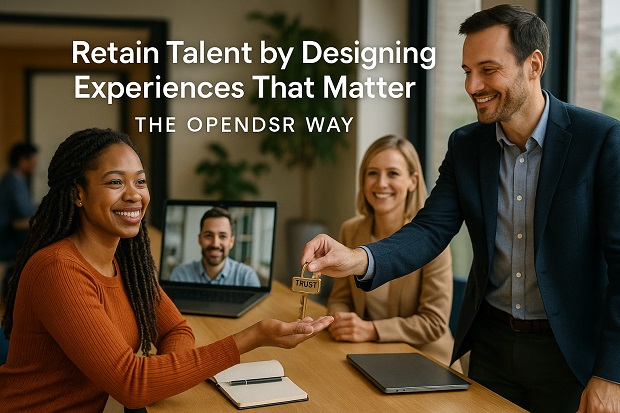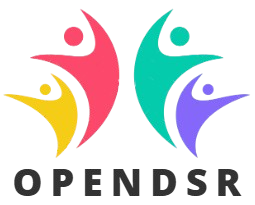
How OPENDSR Strengthens Retention Strategies: Designing Loyalty That Lasts
Retention Is the New Recruitment
In today’s volatile job market, hiring is no longer the hard part — keeping talent is.
Organizations spend millions on recruitment campaigns, yet lose employees within the first year. The cost of replacing one experienced professional can exceed 150% of their annual salary.
But beyond cost, there’s a deeper loss — of culture, trust, and momentum.
When people leave, it’s rarely for money alone. They leave because:
- They don’t feel heard.
- Growth paths are unclear.
- Culture feels mechanical, not meaningful.
Retention is no longer about perks — it’s about purpose, belonging, and experience.
And that’s exactly what OPENDSR was built for.
The Real Problem with Retention
Traditional retention strategies focus on rewards and policies, not real experiences.
Annual engagement surveys, generic development plans, and recognition programs may look good on paper — but they often fail to connect to the daily reality of employees.
A few common breakdowns:
- Leaders learn about disengagement after people resign.
- Career growth paths are documented, not discussed.
- Recognition feels transactional, not personal.
- Feedback loops close too slowly to rebuild trust.
In short: organizations are analyzing turnover instead of designing loyalty.
That’s where OPENDSR brings transformation — by turning empathy into structure.
What OPENDSR Brings to Retention
OPENDSR — Operating Principles for Empathy-led Navigation, Design Standards, and Real-time Intelligence — gives organizations a living operating system for employee experience.
Instead of asking “Why are people leaving?”, OPENDSR helps you design the conditions that make people want to stay.
Through its 7-step operating cycle, retention becomes a continuous rhythm of empathy, design, and refinement.
The 7-Step OPENDSR Retention Cycle
Step
How It Strengthens Retention
1. Observe 👀
Detect early disengagement signals through real-time listening.
2. Prioritize 🎯
Focus efforts on the friction points driving exits (e.g., growth, workload).
3. Envision 🧠
Co-create a retention journey employees want to be part of.
4. Navigate 🗺️
Map touchpoints from stay interviews to career growth rituals.
5. Design ✏️
Build clear, inclusive standards for recognition, feedback, and development.
6. Systematize ⚙️
Automate retention rituals and visibility dashboards.
7. Refine 🔄
Adjust continuously based on pulse data and exit learnings.
Step 1: Observe – Listen Before They Leave
Retention starts with listening early and continuously.
OPENDSR’s Observe phase replaces annual surveys with continuous listening loops:
- Micro pulse surveys on workload, clarity, and connection.
- Sentiment analysis from collaboration tools (Teams, Slack).
- Stay interviews focused on what makes people stay, not why they might leave.
Signals are captured across tools and mapped into Experience Dashboards, revealing trends long before turnover begins.
Example:
An IT firm discovered rising “silent disengagement” in mid-level managers. Analysis showed reduced peer recognition and unclear progression paths. Acting early prevented exits before they started.
Step 2: Prioritize – Identify Friction that Pushes People Away
Retention efforts fail when they spread too thin.
OPENDSR’s Prioritize phase helps focus on what truly drives exits — using a Friction Priority Matrix combining:
- Impact (on morale, trust, performance)
- Frequency (how often it occurs)
- Fixability (how easily it can be improved)
Examples of top retention frictions:
- Lack of visible career paths
- Managerial inconsistency
- Recognition blind spots
- Poor work-life rhythm
By mapping these, leaders can act surgically — fixing the right pain points, not the loudest ones.
Step 3: Envision – Co-Creating the Stay Experience
What makes employees stay isn’t policy — it’s purpose and connection.
In OPENDSR’s Envision step, teams design the Stay Journey collaboratively, asking:
- What moments make people feel proud to work here?
- When do they feel invisible or overlooked?
- How do we celebrate contribution before crisis?
Workshops with diverse employees generate powerful insights:
- Mid-level engineers requested structured mentorship.
- Operations teams asked for flexibility, not bonuses.
- HR realized recognition programs missed remote staff.
This is how retention transforms from a statistic to a shared design challenge.
Step 4: Navigate – Mapping the Retention Journey
After envisioning, OPENDSR helps navigate retention like a designed lifecycle.
Instead of reactive efforts, teams create Retention Roadmaps that define:
- Critical Moments: stay interviews, 1-year reflections, milestone check-ins.
- Owners: HR, managers, peers.
- Systems: Where actions live — Teams, LMS, Intranet, etc.
- Metrics: Belonging score, clarity index, recognition frequency.
Example roadmap (Quarterly cadence):
- Q1: Stay interviews + growth plan updates
- Q2: Peer appreciation week + recognition dashboard review
- Q3: Career mobility sprint + pulse on leadership trust
- Q4: Reflection + redesign cycle (Refine phase)
This structured rhythm turns retention into an ongoing design practice.
Step 5: Design – Building the Culture Glue
This is where retention becomes visible.
OPENDSR’s Design phase transforms insights into concrete standards and rituals.
Examples of Retention Design Standards:
- Manager 1:1 Playbook: empathy-first conversations every 45 days.
- Recognition Culture Map: every role has a recognition rhythm.
- Growth Canvas: visible, co-owned progression plan.
- Belonging Signals: informal rituals — team rituals, virtual shout-outs, milestone stories.
These elements aren’t HR documents — they are the cultural glue that makes people stay.
“When culture is designed with intention, loyalty is no longer luck.”
Step 6: Systematize – Make Loyalty a Habit, Not an Event
Retention cannot depend on goodwill alone — it must be systemized.
In OPENDSR’s Systematize phase:
- Automated stay interviews trigger every 6 months.
- Engagement bots nudge managers when recognition drops.
- Experience dashboards track loyalty indicators live.
- Smart alerts flag high-risk disengagement patterns.
By integrating into tools employees already use — Teams, SharePoint, HRIS — retention becomes part of the daily rhythm.
Case example:
A global logistics firm automated manager recognition reminders through Microsoft Teams. Peer-to-peer shout-outs rose 48%, and voluntary turnover dropped 19% in one year.
Step 7: Refine – Turning Exit Data into Retention Wisdom
Even the best systems need evolution.
OPENDSR’s final phase — Refine — transforms feedback and exit data into learning.
Every quarter, HR and managers review:
- Why people stayed.
- Why some left.
- What signals preceded exit.
- Which experiences improved retention most.
This creates a Retention Journal — a living document of lessons that fuel future design.
Instead of fearing attrition reports, teams now use them as intelligence inputs to evolve continuously.
“Every exit teaches you how to build a better stay.”
Case Study: How a Financial Enterprise Reduced Attrition by 30%
A 5,000-employee fintech company applied OPENDSR to tackle 22% annual attrition.
The Challenge:
- Mid-level analysts leaving within 18 months.
- Poor manager communication.
- No real-time feedback on burnout.
The OPENDSR Approach:
- Observe: Pulse data showed “lack of visibility in growth.”
- Prioritize: Focused on manager empathy and recognition.
- Envision: Co-designed career map templates with employees.
- Navigate: Built retention roadmap with quarterly “Stay Conversations.”
- Design: Introduced “Recognition Fridays” on Teams.
- Systematize: Automated nudges + dashboards.
- Refine: Reviewed exit themes quarterly, adjusted growth plans.
Results after 9 months:
- Attrition down from 22% to 15%.
- Manager trust scores up 28%.
- Internal mobility increased by 33%.
- Stay Interview participation 2.5× higher.
Voices from the Field
“We stopped guessing why people leave. Now we design why they stay.”
— Head of People Operations, FinTech
“Retention is no longer a quarterly panic meeting — it’s a rhythm.”
— Senior HRBP, SaaS Organization
“OPENDSR gave us visibility we never had — our culture now runs on real-time insight.”
— CHRO, Global Manufacturing Firm
Quantifiable Impact of OPENDSR Retention
Retention KPI
Average Improvement (6–12 months)
Description
Voluntary Attrition
↓ 20–35%
Driven by proactive signal detection
Internal Mobility
↑ 30–40%
Clearer growth pathways
Manager Trust Score
↑ 25%
Empathy-led check-in standards
Recognition Frequency
↑ 45%
Systematized rituals
Engagement in Year 2
↑ 28%
Sustained culture rhythm
Cost of Turnover
↓ 15–20%
Preventive design over reactive hires
These outcomes prove what OPENDSR always stood for: Design out friction, design in loyalty.
Integration with Digital Workplaces
OPENDSR retention design easily fits within digital ecosystems such as:
- CorporateOne (SharePoint-based EX platform): for dashboards, recognition feeds, and stay interview logs.
- Microsoft Teams: for manager nudges, peer recognition, and check-in bots.
- Power BI: for visualizing retention and sentiment trends.
- Slack or HRMS integrations: for automated feedback and pulse surveys.
By combining data with empathy, organizations gain not just visibility — but the ability to act in real time.
Retention as a Measure of Trust
At its core, retention is not about policies, bonuses, or benefits — it’s about trust.
Trust that your organization listens.
Trust that growth is possible.
Trust that recognition is fair.
Trust that leadership acts when it matters.
OPENDSR strengthens that trust by embedding empathy, structure, and intelligence into every stage of the employee lifecycle — transforming retention from a reaction into a rhythm.
“When experience becomes the operating system, loyalty becomes the default.”








